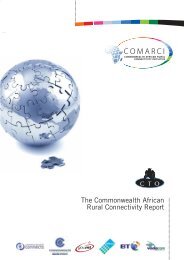ict in agriculture - Commonwealth Telecommunications Organisation
ict in agriculture - Commonwealth Telecommunications Organisation
ict in agriculture - Commonwealth Telecommunications Organisation
Create successful ePaper yourself
Turn your PDF publications into a flip-book with our unique Google optimized e-Paper software.
SECTION 1 — OVERVIEW OF ICT IN AGRICULTURE: OPPORTUNITIES, ACCESS, AND CROSS-CUTTING THEMES 23<br />
BOX 2.3: Balanc<strong>in</strong>g Quality and Service <strong>in</strong> Reach<strong>in</strong>g Rural<br />
Areas: Fixed-l<strong>in</strong>e versus Wireless Backhaul<br />
Even though wireless is accepted as an economical<br />
option for deliver<strong>in</strong>g “last mile” connectivity, backhaul<br />
traffic is usually carried via fiber-optic networks because<br />
of their high capacity. Connectivity is often limited by the<br />
limited penetration of the fixed-l<strong>in</strong>e backhaul that supports<br />
it. The delivery of connectivity to rural areas lack<strong>in</strong>g<br />
fixed-l<strong>in</strong>e backhaul <strong>in</strong>volves balanc<strong>in</strong>g concerns about<br />
ICT access, connection quality, and the expenditures<br />
and delays entailed <strong>in</strong> roll<strong>in</strong>g out fixed l<strong>in</strong>es and support<strong>in</strong>g<br />
<strong>in</strong>frastructure. The benefits of wireless backhaul<br />
technology are worth consider<strong>in</strong>g <strong>in</strong> such cases.<br />
Wireless backhaul is <strong>in</strong>creas<strong>in</strong>gly recognized as an<br />
option for combat<strong>in</strong>g the expenditures <strong>in</strong>volved <strong>in</strong> provid<strong>in</strong>g<br />
fixed-l<strong>in</strong>e rural connectivity. Wireless network<br />
backhaul solutions can take the form of po<strong>in</strong>t-to-po<strong>in</strong>t<br />
or po<strong>in</strong>t-to-multipo<strong>in</strong>t wireless Ethernet bridges or wireless<br />
mesh networks. They can use licensed or unlicensed<br />
microwave l<strong>in</strong>ks (see Unlicensed Wireless Use).<br />
With throughput from as low as 10 Mbps up to GigE<br />
full duplex (with gigabit wireless), a licensed microwave<br />
l<strong>in</strong>k or wireless bridge can provide sufficient capacity for<br />
many rural applications. Because it is compatible with<br />
mobile phone standards (GSM, CDMA), the WiMAX<br />
standard offers opportunities for roll<strong>in</strong>g out affordable<br />
wireless rural backhaul. Advocates of the technology are<br />
optimistic about its potential for l<strong>in</strong>k<strong>in</strong>g wireless fixedlocation<br />
base stations to the core network.<br />
Source: Authors.<br />
Note: Mbps = megabit per second; GigE = Gigabit Ethernet; GSM =<br />
Global System for Mobile Communication; CMDA = Code Division Multiple<br />
Access (CDMA) 2000, a wireless air <strong>in</strong>terface standard; WiMAX =<br />
Worldwide Interoperability for Microwave Access.<br />
made up of telephone l<strong>in</strong>es, fiber-optic cables, microwave<br />
transmission l<strong>in</strong>ks, mobile networks, communications satellites,<br />
and undersea telephone cables.<br />
The difference between the two k<strong>in</strong>ds of networks lies <strong>in</strong><br />
their switch<strong>in</strong>g mechanisms. Under circuit switch<strong>in</strong>g, the<br />
connection is established on a predeterm<strong>in</strong>ed, dedicated,<br />
and exclusive communication path for the whole length of<br />
the communication session. Consequently, PSTN connectivity<br />
is costly. In packet-switch<strong>in</strong>g protocols, such as IP, the<br />
communicated data are broken <strong>in</strong>to sequentially numbered<br />
packets, each of which is transmitted to the dest<strong>in</strong>ation via<br />
an <strong>in</strong>dependent path, and then the packets are reassembled.<br />
In packet-switch<strong>in</strong>g, the potential for congestion, packet loss,<br />
ECONOMIC AND SECTOR WORK<br />
and delay can mar the quality of the connection. A comparison<br />
between traditional fixed-l<strong>in</strong>e telephone services and voice<br />
over IP (VoIP) clearly demonstrates the difference between<br />
the two types of networks. NGNs completely separate the<br />
packet-switched transport (connectivity) layer and the service<br />
layer, enabl<strong>in</strong>g any available fixed-l<strong>in</strong>e carriage <strong>in</strong>frastructure<br />
to be used efficiently for any service.<br />
Domestic Backbone and Rural Backhaul Connectivity<br />
As end users’ demand for additional bandwidth grows, <strong>in</strong>sufficient<br />
domestic backbone can pose a considerable challenge<br />
to the roll-out of fixed-l<strong>in</strong>e broadband services. In the<br />
mobile sector, <strong>in</strong>sufficient backhaul capacity is becom<strong>in</strong>g a<br />
limitation, particularly with the <strong>in</strong>crease of rural 3G data use.<br />
Government <strong>in</strong>terventions <strong>in</strong> support of rural backhaul solutions<br />
have <strong>in</strong>cluded the <strong>in</strong>troduction of public-private fund<strong>in</strong>g<br />
mechanisms (as <strong>in</strong> Korea and Chile; see box 2.4), construction<br />
subsidies (as <strong>in</strong> Canada), and the rollout of fiber-optic<br />
networks connect<strong>in</strong>g public <strong>in</strong>stitutions (Rossotto et al. 2010).<br />
Complementary regulations can be used to ensure competitive<br />
conditions <strong>in</strong> the provision of domestic backbone and rural<br />
backhaul. The policy tools for support<strong>in</strong>g domestic backbone<br />
rollout and rural backhaul connectivity <strong>in</strong>clude <strong>in</strong>frastructure<br />
shar<strong>in</strong>g, 10 functional separation, 11 and cross-ownership restr<strong>ict</strong>ions,<br />
allow<strong>in</strong>g for <strong>in</strong>terplatform competition12 ( Dartey 2009).<br />
Local Loop or “Last Mile” Connectivity<br />
The delivery of network access <strong>in</strong> the “last mile” is the most<br />
costly and challeng<strong>in</strong>g element of rural deployments. The<br />
technology options for deliver<strong>in</strong>g wired local loop broadband<br />
connectivity <strong>in</strong>clude the rollout of xDSL, 13 cable, and fiber to<br />
the home <strong>in</strong>frastructure. Wireless options <strong>in</strong>clude the rollout<br />
of mobile (2G, 3G, 4G), 14 wireless broadband (WiMAX, Wi-Fi,<br />
10 “Infrastructure shar<strong>in</strong>g” is a mechanism for reduc<strong>in</strong>g capital<br />
expenditures and operat<strong>in</strong>g expenditures. Passive <strong>in</strong>frastructure<br />
shar<strong>in</strong>g consists of colocat<strong>in</strong>g competitors. Active <strong>in</strong>frastructure<br />
shar<strong>in</strong>g consists of shar<strong>in</strong>g the network base station controllers,<br />
both circuit-switched and packet-oriented doma<strong>in</strong>s, mobile services<br />
switch<strong>in</strong>g center, GPRS support node, and so on.<br />
11 In “functional separation,” an <strong>in</strong>cumbent operator is required to<br />
establish separate divisions for manag<strong>in</strong>g fixed-l<strong>in</strong>e services and<br />
provid<strong>in</strong>g wholesale services to retail competitors.<br />
12 Cross-ownership restr<strong>ict</strong>ions prevent operators, such as telephony<br />
operators, to control competitive network <strong>in</strong>frastructure,<br />
such as cable television networks. For example, restr<strong>ict</strong>ions may<br />
be placed on the simultaneous control of telephony and cable<br />
television network <strong>in</strong>frastructures <strong>in</strong> a specified area.<br />
13 xDSL refers to all digital subscriber l<strong>in</strong>e (DSL) technologies.<br />
14 2G mobile wireless has basic functionality: voice and short messag<strong>in</strong>g<br />
service (SMS); 3G has advanced functionality: general<br />
packet radio service; and 4G has broadband functionality: longterm<br />
evolution (LTE).

















